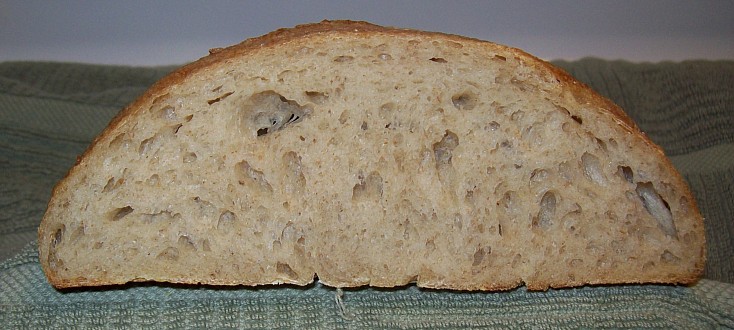Breaking through $100 per loaf!
For months I have tried a variety of techniques, methods, and recipes, etc. to develop a starter and a sourdough loaf to meet my picky requirements of what a good loaf of sourdough should look like a give me the tanginess, chew, and flavor I sought. In the process it was costing me about $100 per loaf to make. I have to include the energy to run my oven, the utilities to cool my home, the water to wash the utensils, pans, & wash down the drain my discard, plus the bags of flour required to maintain my starters. This struff gets expensive. Oh and lest not forget scales, thermometers, containers, mixers, and the list continues.
But, I am pleased to announce that at last a method and technique from one of TFL forum members has been a success.
Pleas see post=> http://www.thefreshloaf.com/node/18651/sourdough-123-method by jstreed1476.
The Flo Makanai's 1.2.3 method combined with Dan Lepard's bread kneading technique provides wonderful results. Flour, Water, Salt, and Starter, thats all you need.
Here's the formula:
100 g Starter (100% Hydration)
200 g Water
35 g Whole-Wheat Flour
15 g Rye Flour Hydration: 71.4%
250 g Bread Flour
7 g Salt Salt
Mix starter and water, add whole wheat and rye flours, and next add the bread flour, approximately 50 grams at a time.
After all flours are mixed and hydrated, let rest 20 minutes. Add salt, knead about 1 minute on a lightly oiled counter; proceed with the resting-kneading sequence in Dan Lepard fashion: (rest 10 minutes, knead 10 secs; rest 10 minutes, knead 10 secs; rest 30 minutes, knead 10 secs; rest 1 hour, knead 10 secs).
After that sequence is over, let dough rise about 90 minutes, then preshape, rest, and shape before placing it in a long basket with a floured tea towel. Proof about 3.5 hours at 75F, at which point it should pass the spring-back poke test. Load loaf onto a peel, then place onto the baking stone. Bake and steam at 500º F for 5 minutes, covered with a roasting pan. Reduce heat to 450º F and continue baking another 15 minutes or until internal temp is about 210º F. Cool, cut, and enjoy.
This dough is pretty slack before final shaping and would make a good pizza crust.
The use of the 1-2-3 Method combined with the incredibly effective, non-labor-intensive kneading protocol advocated by Lepard makes this a good break baking method.
What I changed is instead of using a roasting pan to cover the dough, I just used a covered medium size roasting pan and spayed water on the loaf and inside the pan and lid.
Works great - here's pics:

CRUM & RISE

The first fe slices did not make it in the photo. Those were the baker's test pieces.
That looks great.
Thanks for posting the history and the formula, too. That helps the rest of us (home-bakers) quite a lot.
So, when can I come over for a salami, Swiss cheese and pickle sandwich, eh?
;-)
Warm regards,
copyu
good to see you having some success, nothing finer to drive you onwards, lets hope the family gets behind you.
regards yozza
Happy I could pass along the wisdom of other bakers :-)
Funny: when I describe some of these "newer" methods to more casual bakers, their eyes sort of glaze over, and they almost always say something like, "Whoa, that's way too complicated for me."
Occasionally, both here and on other sites, there's a bit of what you might call "false tension" between experimental, artisan-minded bakers and more conventional bakers. Which is a bit of a shame, and many here work hard to remedy that. The common denominator among all of us, however, is that we think homemade is best, no?